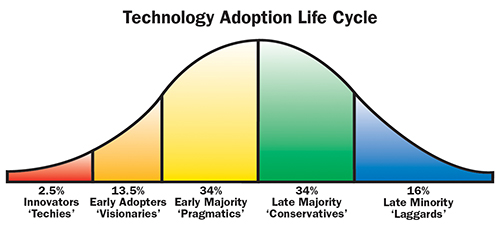What do you think about new technology? Do you want new things as soon as they’re available? Or do you wait until a new concept is proven and tested before you adopt it?
This column explains words we often use when selling new machines and technology: innovators, early adopters, laggards, etc., and examines how our own views about technology can be better leveraged in our own dealerships.
These concepts also apply to segmenting your customer base to determine which type of customers you should pursue when introducing new technology products.
For those of us in farm equipment, it’s interesting to note that the subject of how technology is adopted today is still largely driven by research done in the 1950s and centers on the speed by which farmers adopted the use of hybrid seed corn. Marketers of all products — cars, cell phones, flat screen TV’s, tooth paste — use the same methods and vocabulary first introduced by extension agents at Iowa State Univ.* based on research by Neal C. Gross and Bryce Ryan.
Their concepts are as relevant today as they were then. Adoption of a wide range of Information and Communication Technology (ICT) can be better understood through the theory of technology diffusion and adoption that started with the introduction of hybrid seed corn.
Life Cycle of a New Idea
The model of how any technology is adopted considers that different people take a longer or shorter amount of time to feel comfortable with a new idea. The differences among people can be explained by individual characteristics. In the case of farmers, the differences relate to farm size, education and age.
|
Farmers and dealers fit the classic bell curve when it comes to adopting technology, with a few people at the ends of the curve and far more in the middle.
|
Another consideration is that there are big differences in the size of each group. The distribution in numbers is a classical bell curve with a few people at the beginning and the end of the curve and a lot of people in the middle.
Based on the 1957 hybrid seed corn research, the description and insights about each group are as follows:
Innovators — ‘Techies.’ This is the smallest group. They tend to operate larger farms, have more education, are more profitable and bigger risk takers. They like what’s new and are willing to take risks that it may not work correctly at first
Early Adopters — ‘Visionaries.’ This is the next smallest group, but they’re also the most important. They tend to be younger and more educated. Many are community leaders even if they’re not the most profitable. They look ahead and often don’t pay much attention to the bottom line.
Early Majority — ‘Pragmatics.’ This is large group — about one-third of the total who are more conservative in terms of risk but who are open to new ideas. They are active in the community and can influence their more conservative neighbors. They watch the Innovators, but more importantly, they watch the Early Adopters to see whether a new technology works before trying it themselves. Pragmatics are practical in sorting out how to make technology profitable and useful.
Late Majority — ‘Conservatives.’ This group also comprises about one-third of the total. They tend to be older, less educated and less socially active. They will not adopt until they see that the Early Majority has fully adopted a new technology.
Late Minority — ‘Laggards.’ This group represents the end of the technology adoption tail. It is a fairly large group who tend to be very conservative. They operate the smallest farms, are the oldest in terms of age groups and often the least educated.
Technology & Time
Historically, it takes 40 years for a new idea to become fully accepted. In other words, it is a long time from when a Techie first uses a new idea to when a Laggard finally adopts it. And adoption is a process the profitable Early Majority Pragmatists won’t take on until the Early Adopter Visionaries do. Likewise, the large Late Majority Conservatives won’t until they see that the Pragmatists are successful.
However, the pace of adopting new technology is increasing. Last month’s Technology for Profit column was titled, “Are You Ready for the 2nd Machine Age?” The message of that article is that we are already into what is called the second half of the chessboard when the power of ICT is increasing exponentially. This means that you, your dealership and your customers will have more and more changes to adopt coming at you faster rate.
Adopting Technology
What does all of this mean for you at your dealership and how can you take the knowledge discussed here and profitably apply it to your business? Start by asking these 3 questions:
1. Are you part of the problem or part of the solution?
If, personally, you are a Conservative — meaning the Late Majority in terms of speed of adopting new technology — does this hinder consideration and acceptance of new, profitable ideas in your dealership? How does your attitude about technology affect those of your employees and, in turn, affect your employees’ approach to customers — one way or another?
2. Do you know who the Techies, Visionaries and Pragmatists are in your organization?
Because technology adoption is a process, which individuals in your dealership are looking out for new ideas (Techies), making them work (Visionaries) and applying them profitably (Pragmatists)?
3. Do you have a process of sorting out new ideas early so that you can more quickly move from the early stages to the later ones where technology is most profitable for your dealership?
The more quickly your organization assesses new products and approaches, the more quickly it will be able to take advantage of them. If you understand your attitude toward new technology (see question #1) and know the key people who can introduce and apply it (see question #2), the more efficiently you will be able to push the process through the technology life cycle.
We’ve come a long way since the introduction of hybrid seed corn taught us about how people and groups adopt new technologies, and we are still learning from it. Put that knowledge to work in your dealership because it still applies today.
*(Bohlen, Joe M.; Beal, George M., May 1957, “The Diffusion Process,” Special Report No. 18, Agriculture Extension Service, Iowa State College)







